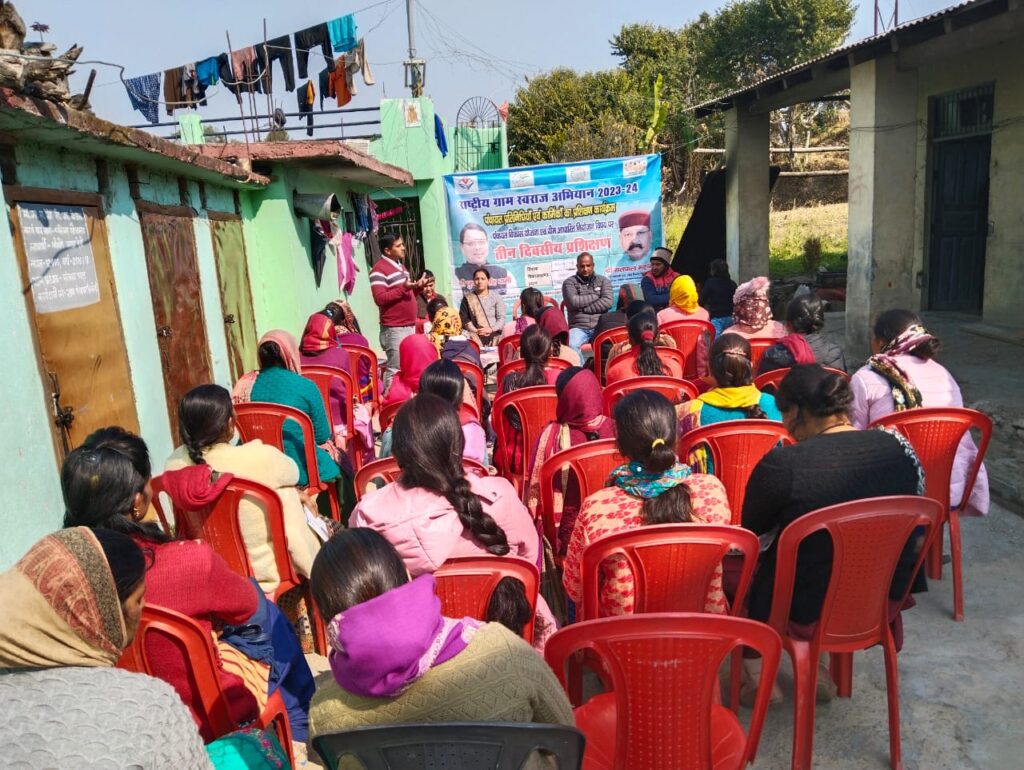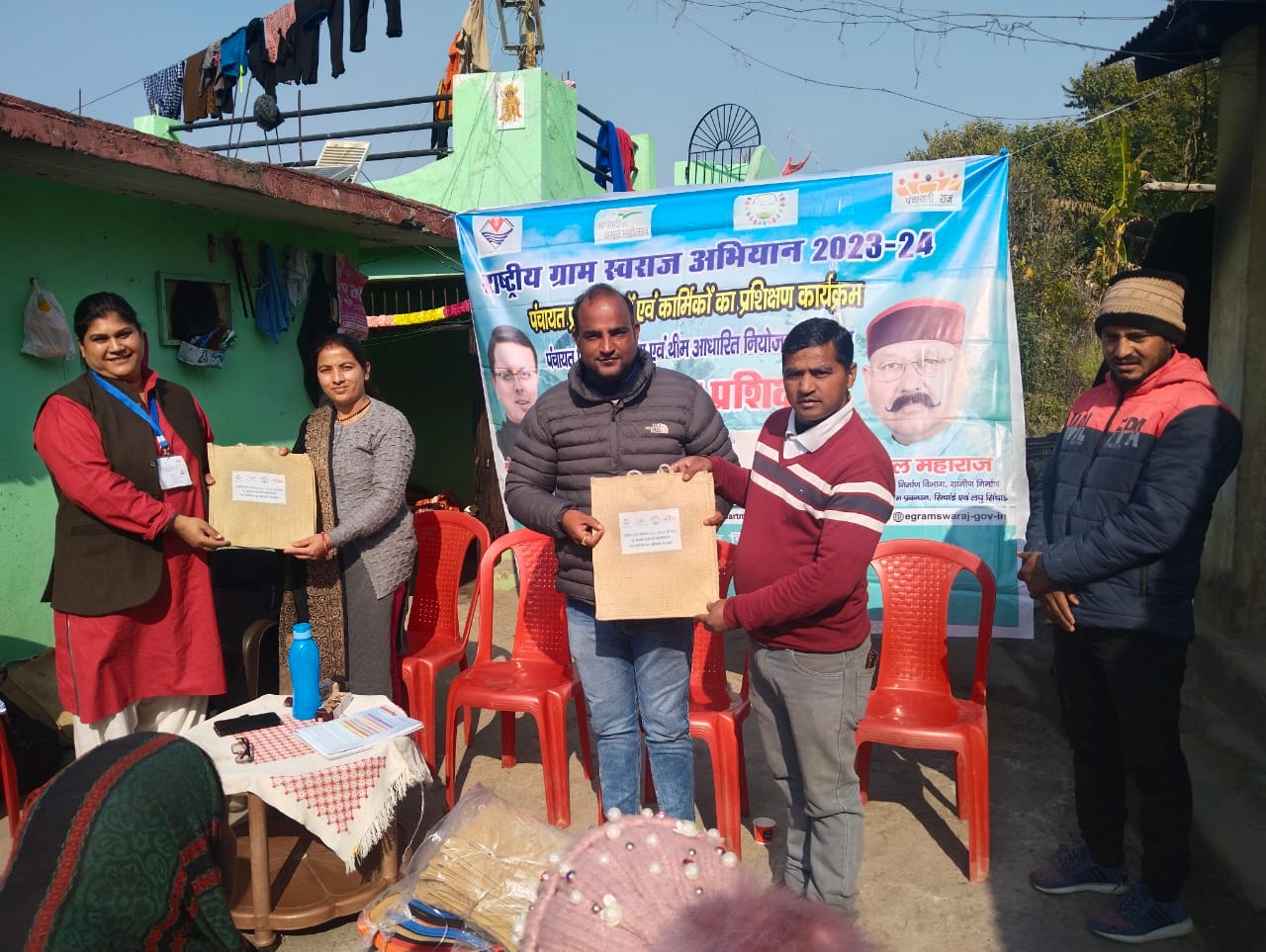Panchayat plays a pivotal role in different developmental challenges like poverty, public health, nutrition, education, gender, sanitation, drinking water, livelihood generation etc which are in sync with SDGs. Hence, Panchayats are identified as key players in the localization of SDGs adopting the 9 thematic approaches.
A three day training program on localization of sustainable
development goals and formulation of Gram Panchayat Development Plans was conducted from
29thJanuary’24 to 06th February’24 for the representatives and personnel of three-tier Panchayats
under the campaign of Rashtriya Gram Swaraj Abhiyaan (RGSA) of Panchayati Raj
Department, Uttarakhand at block Lohaghat of district Champawat, Uttarakhand by Care in
Need Welfare Society. The training was conducted in Rausal nyay panchayat and block
Lohaghat from 29.01.24 to 31.01.24. In nyay panchayat Baskuni ,Kolidhek and Bhumlai from
01.02.24 to 03.02.24 and in nyay panchayat Dumdai, Kimtoli, Dhorja from 04.02.24 to
06.02.24.

A special session was conducted in Nyaya Panchayat Baskuni where the Principal and teachers
in-charge of Girls Inter College asked the Master trainer to give a session to their girls. In
between the training, Dr. Priti Dimri gave detailed information about women welfare and
adolescent upliftment to the girls of Inter College and the teachers. The teachers then thanked Dr.
Priti saying that the session was very beneficial and the students were very happy.
The objective of the programme was to build the capacities of elected representatives by
understanding the basic components of PRI, focusing on their roles and responsibilities vis-a-vis
facilitating the preparation of Gram Panchayat development plans .
The first day’s programme began with participant registration, followed by an initial session. The
seminar began by notifying attendees that India has signed the Sustainable Development Goals
(SDGs) for 2030. The Ministry of Panchayati Raj (MoPR) is committed to achieving the SDGs
through the Rastriya Gramme Swaraj Abhiyan (RGSA) Scheme. Panchayat Raj Institutions, as
the closest institutions to villagers, are best suited to designing and implementing locally relevant
policies associated with the SDGs.
The Ministry acknowledges the critical role of Gramme
Panchayats (local self-government bodies) in achieving the SDGs and promoting inclusive and
sustainable development in rural communities. Participants were informed that MoPR’s
Localization of Sustainable Development Goals (LSDGs) refers to the process of aligning and
integrating the 17 global SDGs into grassroots development planning and execution. In order to
guarantee that No One Is Left Behind and No Village Is Left Behind, it was underlined
throughout the training that the LSDGs take on an even more significant role in achieving the
goals in rural areas. The trainers went on to explain to the participants that the LSDGs are
planned using a thematic approach, in which the 17 SDGs are combined into nine major themes.
The Ministry seeks to accomplish these goals through the coordinated and cooperative efforts of
all stakeholders, with Gramme Panchayats serving as the primary actors in the last mile delivery
of SDG outcomes. Each topic is associated with particular development objectives and targets..

The training was led by Mr. SK Dimri, Dr. Priti, Mrs. Aarti Rawat, Ms. Prisha, ,Mr. Harender,
Mr. Girish Nautiyal , Mr. Mahavir Negi, Ms. Manisha Fartyal , Mr. Chandraprakash Pandey and
Mr. Kamal Joshi all experienced PRI trainer’s and resource person The training was conducted
in 8 nyay panchayat in 10 different batches comprising of 695 participants including Gram
Pradhan’s, ward members, Anganwadi, ASHA, Panchayat members and members of the Line
department.

The trainers said that the localization process uses a thematic approach, whereby the 17 SDGs
are divided into 9 topics that represent different facets of development, such as gender equality,
health, education, and poverty alleviation, as well as sanitation and clean water.
The 73rd Amendment Act was explained by the trainers. They said that the Panchayati Raj Act,
as it is commonly known, was passed by the Indian Parliament in 1992. This amendment sought
to provide local Panchayats more authority to carry out development projects in their own
regions by decentralising decision-making and power away from the federal and state
governments.
The trainers continued by explaining that although village panchayats had been in place in India
for a long time prior to the 1992 act, the system had certain inherent flaws, such as its incapacity
to function as a people’s government that could adapt to their demands.
Numerous issues
Project Completion Report- Page 5 of 32
contributed to this, including a shortage of funding, irregular election schedules, and insufficient
representation of women and scheduled castes/tribes. The Directive Principles of State Policy in
the Constitution of India lays down in Article 40 that the government shall facilitate the
establishment and smooth functioning of the gram panchayats.
The Indian central government enacted the 73rd Amendment Act in 1992 to enhance local selfgovernments
and address these challenges. After passing both chambers, the act became
operative on April 24, 1993. Part IX: The Panchayats is a new chapter that this act adds to the
Constitution. It was also informed to the participants that Panchayati raj institutions have been
considered as instruments of socio economic transformation in rural India. Decentralization of
power to the Panchayats is seen as a means of empowering people and involving them in
decision making process. Local governments being closer to the people can be more responsive
to local needs and can make better use of resources. The democratic system in a country can be
ensured only if there is mass participation in the governance. Therefore, the system of
democratic decentralization popularly known as Panchayati Raj is considered as an instrument to
ensure democracy and socio-economic transformation. From ancient to Mughal period village
bodies were the pivot of administration. In the British period our villages remained backward
and they lacked all the essentials of civilized existence. They lacked all the necessities of
contemporary life, including strong education facilities, public health services, sanitary
conditions, and appropriate communications. The function of local self-government took on
greater importance in independent India.


The three-tier Panchayati Raj system has been given constitutional status. They have the right to
make and implement plans for economic development and social work themselves, under which
Panchayats will be authorized to monitor and verify government works. In this context, the
subjects of the 11th list have been transferred to the Panchayats.
The master trainers led icebreaker activities (team building) for each cohort. Two teams of ten
people each were given a team work assignment. A set of numbers was given to each team, and
each person was invited to take a number. The team chose a single member to serve as team
leader. Being the first team to reorganise to the number you call was the aim of the game. They
were rearranged to their proper places with assistance from the leaders.
The team must raise their
hands and take a position once they have rearranged. One point is awarded to the first team to
appropriately organise themselves. The winning team in a game is the one with 10 points. The
team gains coordination skills via this activity, and because everyone must maintain focus, they
Project Completion Report- Page 6 of 32
discover how crucial it is for each member to function as the team’s engine. All the participants
were very happy when they realized how important it was for them to be united and focused for
the development of their Gram Panchayat. They acknowledged the fact that during their open
meeting (Khuli Baithak) all the members are chaotic there is no outcome of the meeting and they
behaved in the same way as in the game. So they now knew what mistake they were making and
promised to behave properly in the khuli baithak